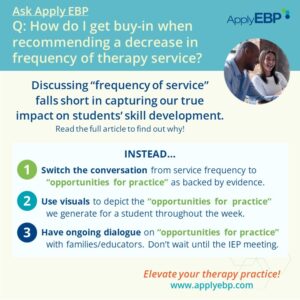Ask Apply EBP
Top 3 Balance Tests for Children with Moderate to Complex Motor Challenges
Note that this article is part of a series of articles on assessment. If you have not done so, first, read this articles:
-
-
-
- Must-Have Test and Organizing Your School-based Assessment – discusses the 5 critical reasons for assessing participation first
- 3 Principles for Selecting Tests – discusses the 3 principles to use when selecting tests at the activity and body function & structure levels
-
-
Q: What are the best tests…for Balance in Children with Moderate to Complex Motor Challenges?
Here are our 3 favorite standardized tests for balance for children with moderate to more complex motor challenges. If you are interested in tests for balance for children with mild to moderate motor challenges, click here.
1. Early Clinical Assessment of Balance (ECAB)
Consists of items from the Pediatric Balance Scale and the Movement Assessment for infants, the ECAB measures head, trunk, sitting, and standing postural control.
-
-
- Test instruction: Click here for the ECAB form with instructions
- Reference Data for children with Cerebral Palsy: Click here
- Equipment needed: bench, mat, timer, step stool about 6” high
- Why we like this test:
- It includes a variety of static and dynamic items, from head righting, protective extension in sitting, and turning 360 degrees in standing.
- The reference data for children with CP is shown as developmental trajectories according to different GMFCS levels, and can, thus, be used to predict future performance.
- What to note: while theoretically, it can be used for different health conditions, current data is only for children with cerebral palsy.
-
2. Posture and Postural Ability Scale (PPAS)
Assesses postural asymmetries in supine, prone, sitting, and/or standing to determine need for support.
-
-
- Test instruction: Click here for test items and instructions
- Reference Data: None; this is a criterion-referenced test
- Equipment needed: typical equipment used for sitting or standing
- Why we like this test:
- It is great for determining need for support that promote symmetrical positioning.
- The client can be tested in a piece of adaptive equipment, such as a stander for standing, or specialized seating for sitting.
- What to note: There is no form provided in the article above. You can easily create a form using the items in the article. You do not have to assess the client in all positions. You can select positions that fits the purpose of your assessment (e.g., sitting for sitting in the classroom, supine for sleeping).
-
3. Segmental Assessment of Trunk Control
Assesses discrete levels of trunk control in children with motor disabilities
-
-
- Test instruction: Click here for the form and procedures
- Equipment needed: bench with strapping for pelvic support
- Why we like this test:
- A more specific testing of trunk control as it assesses the trunk by segment, instead of as one whole unit.
- Helpful in determining the level of trunk support needed in assistive devices to promote the performance of various functional activities.
- What to note: This test requires a special strapping device. See the article for a description of how the strapping works, so you can create one for testing.
-
For more on children with complex motor challenges, check out…
References:
Butler, P. B., Saavedra, S., Sofranac, M., Jarvis, S. E., & Woollacott, M. H. (2010). Refinement, reliability, and validity of the segmental assessment of trunk control. Pediatric physical therapy : the official publication of the Section on Pediatrics of the American Physical Therapy Association, 22(3), 246–257. https://doi.org/10.1097/PEP.0b013e3181e69490
LaForme Fiss, A., McCoy, S. W., Bartlett, D., Avery, L., Hanna, S. E., & Study Team, O. T. (2019). Developmental Trajectories for the Early Clinical Assessment of Balance by Gross Motor Function Classification System Level for Children With Cerebral Palsy. Physical Therapy, 99(2), 217-228. https://doi.org/10.1093/ptj/pzy132
Rodby-Bousquet, E., Ágústsson, A., Jónsdóttir, G., Czuba, T., Johansson, A. C., & Hägglund, G. (2014). Interrater reliability and construct validity of the Posture and Postural Ability Scale in adults with cerebral palsy in supine, prone, sitting and standing positions. Clinical rehabilitation, 28(1), 82-90.
Find More Answers to Your Questions in Our...
Featured School
Symposium
7th Online School-based OT and PT Symposium - On-Demand Version
- Watch and re-watch on your own time
- On-Demand Version
- OTs, OTAs, PTs and PTAs
- $399-449
Featured Live
Workshop
6th Online School-based OT and PT Symposium - On-demand Version
- Watch and re-watch on your own time
- On-Demand Version
- OTs, OTAs, PTs and PTAs
- $399-449
Featured On-Demand
Webinar
Segmental Assessment of Trunk Control
Featured Webinar
Bundle
Complex Disabilities Bundle
Have a question?
Submit here…
*Clicking submit will send your question directly to our email inbox. Your name and email will let us know that your submission is real (not spam). We will not include these in our posts, unless you tell us to include your name. Please read our privacy policy here.
All infographics and videos on www.applyebp.com are intellectual properties of Apply EBP, LLC
You may use the infographics and videos for free for any non-commercial, educational purposes. Please cite the source as “Apply EBP, LLC” and a link to the source article. If you plan to use any infographic or video for commercial purposes (i.e., for profit), please email Carlo@applyebp.com to obtain a written permission. Permission can be granted on a case-by-case basis.










